Plant Science Research Weekly: September 10, 2021
Review: Root plasticity under abiotic stress
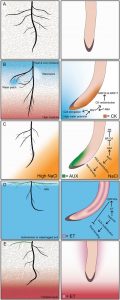 For millennia, humans have selected desirable traits in the above-ground part of plants, but below-ground traits have been only indirectly selected. Thus, roots are ripe for optimization, and hold particular promise in efforts to make crops more resilient and efficient. This Update, by Karlova et al., describes our current understanding of the molecular basis for root responses to too little water, gradients of salt or soil impermeability, or oxygen deprivation. These mechanisms draw on a suite of well-described hormone pathways, and affect various aspects of root system architecture including primary root arrest, elongation, or bending; lateral root initiation and angle and rate of outgrowth; root hair growth; as well as anatomical changes such as the formation of air channels (aerenchyma) or barrier formation through suberinization. Although we are beginning to tease apart root responses to single abiotic stresses, the question of how roots cope with multiple stresses is still unanswered. (Summary by Mary Williams @PlantTeaching) Plant Physiol. 10.1093/plphys/kiab392
For millennia, humans have selected desirable traits in the above-ground part of plants, but below-ground traits have been only indirectly selected. Thus, roots are ripe for optimization, and hold particular promise in efforts to make crops more resilient and efficient. This Update, by Karlova et al., describes our current understanding of the molecular basis for root responses to too little water, gradients of salt or soil impermeability, or oxygen deprivation. These mechanisms draw on a suite of well-described hormone pathways, and affect various aspects of root system architecture including primary root arrest, elongation, or bending; lateral root initiation and angle and rate of outgrowth; root hair growth; as well as anatomical changes such as the formation of air channels (aerenchyma) or barrier formation through suberinization. Although we are beginning to tease apart root responses to single abiotic stresses, the question of how roots cope with multiple stresses is still unanswered. (Summary by Mary Williams @PlantTeaching) Plant Physiol. 10.1093/plphys/kiab392
Plants People Planet Special Issue: Mycorrhizas for a changing world
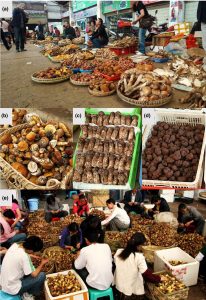 Plants People Planet is a relatively young journal that launched in 2019. It’s aim is to explore aspects of plant science directly relevant to our daily lives, and how plant science is communicated to the public. The Sept 2021 issue has a focus on mychorrhizas, which it explores through several opinion, review, and research articles. Topics span the communication of mycorrhizal importance, applications of mycorrhizal research to environmental sustainability as well as to medium-sized farms, responses of root-fungal interactions to a warming climate, and many more. Perhaps the most fun and fascinating article from this collection (to me) is the article on Edible mycorrhizal fungi of the world – yum yum. (Summary by Mary Williams @PlantTeaching) Plants People Planet, Sept. 2021.
Plants People Planet is a relatively young journal that launched in 2019. It’s aim is to explore aspects of plant science directly relevant to our daily lives, and how plant science is communicated to the public. The Sept 2021 issue has a focus on mychorrhizas, which it explores through several opinion, review, and research articles. Topics span the communication of mycorrhizal importance, applications of mycorrhizal research to environmental sustainability as well as to medium-sized farms, responses of root-fungal interactions to a warming climate, and many more. Perhaps the most fun and fascinating article from this collection (to me) is the article on Edible mycorrhizal fungi of the world – yum yum. (Summary by Mary Williams @PlantTeaching) Plants People Planet, Sept. 2021.
Review: Evolutionary innovations driving abiotic stress tolerance in C4 grasses and cereals
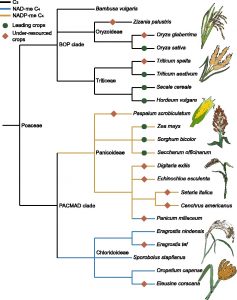 Grasses fall into two clades, the more temperate BOP clade of C3 grasses (Bambusoideae, Oryzoideae, and Pooideae subfamilies), and the more tropical PACMAD clade of C3 and C4 grasses (Panicoideae, Arundinoideae, Chloridoideae, Micrairoideae, Aristidoideae, and Danthonioideae subfamilies). This review, by Pardo and VanBuren, explores the origins of abiotic stress tolerance in the PACMAD clade, which includes important tropical crops such as sorghum, maize, sugarcane, millet, and teff. This fascinating review addresses many traits that evolved independently in grasses (such as their unique stomatal shape and Kranz anatomy) as well as those that are adaptations of those found in other plants, such as their fibrous root system. The authors explore the relationship between C4 biochemistry and anatomy and water use efficiency, and discuss factors that make members of the Chloridoideae (millet, teff) more salt and desiccation tolerant than other grasses. Finally, they discuss how these insights can be applied toward improving climate resilience in our crops. (Summary by Mary Williams @PlantTeaching) Plant Cell 10.1093/plcell/koab205
Grasses fall into two clades, the more temperate BOP clade of C3 grasses (Bambusoideae, Oryzoideae, and Pooideae subfamilies), and the more tropical PACMAD clade of C3 and C4 grasses (Panicoideae, Arundinoideae, Chloridoideae, Micrairoideae, Aristidoideae, and Danthonioideae subfamilies). This review, by Pardo and VanBuren, explores the origins of abiotic stress tolerance in the PACMAD clade, which includes important tropical crops such as sorghum, maize, sugarcane, millet, and teff. This fascinating review addresses many traits that evolved independently in grasses (such as their unique stomatal shape and Kranz anatomy) as well as those that are adaptations of those found in other plants, such as their fibrous root system. The authors explore the relationship between C4 biochemistry and anatomy and water use efficiency, and discuss factors that make members of the Chloridoideae (millet, teff) more salt and desiccation tolerant than other grasses. Finally, they discuss how these insights can be applied toward improving climate resilience in our crops. (Summary by Mary Williams @PlantTeaching) Plant Cell 10.1093/plcell/koab205
TEM1 combinatorially binds to FLOWERING LOCUS T and recruits a Polycomb factor to repress the floral transition in Arabidopsis
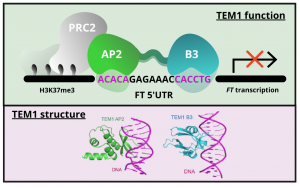 Gene expression is primarily controlled by transcriptional regulatory proteins able to recognize and bind short DNA sequences in downstream targets. Understanding how DNA-binding proteins achieve high precision and switch on/off the transcription of selected genes at a specific developmental stage or in response to a specific environmental stimulus has been one of the major goals of research in the field of molecular biology. In this paper, Hu and colleagues investigated the structure and function of the floral repressor TEMPRANILLO1 (TEM1), characterized by an N-terminal AP2 and central B3 domains. In Arabidopsis, TEM1 negatively regulates flowering time under non inductive conditions by directly repressing the florigen FLOWERING LOCUS T (FT). The authors first determined the crystal structure of the AP2 and B3 DNA binding domains and identified residues involved in the recognition of cis-acting elements present in FT 5’UTR. They also analyzed the affinity between different versions of TEM1 and a DNA probe containing both AP2 and B3 elements. In vitro binding assays revealed that the combination of the two protein domains increased affinity to the target sequence, while mutations in key residues or deletions disrupted the DNA-protein interaction. In planta, the expression of mutated or deleted forms of TEM1 failed to rescue the early flowering phenotype of tem mutants, suggesting that both domains are required to regulate the florigen. TEM1 also interacts with the catalytic subunit of the Polycomb Repressor Complex 2 (PRC2), responsible for the deposition of repressive marks at target loci. Thus, TEM1 binds to specific sequences of FT and recruits chromatin remodeling factors to trigger its epigenetic silencing. (Summary and image adaptation by Michela Osnato @michela_osnato) PNAS 10.1073/pnas.2103895118
Gene expression is primarily controlled by transcriptional regulatory proteins able to recognize and bind short DNA sequences in downstream targets. Understanding how DNA-binding proteins achieve high precision and switch on/off the transcription of selected genes at a specific developmental stage or in response to a specific environmental stimulus has been one of the major goals of research in the field of molecular biology. In this paper, Hu and colleagues investigated the structure and function of the floral repressor TEMPRANILLO1 (TEM1), characterized by an N-terminal AP2 and central B3 domains. In Arabidopsis, TEM1 negatively regulates flowering time under non inductive conditions by directly repressing the florigen FLOWERING LOCUS T (FT). The authors first determined the crystal structure of the AP2 and B3 DNA binding domains and identified residues involved in the recognition of cis-acting elements present in FT 5’UTR. They also analyzed the affinity between different versions of TEM1 and a DNA probe containing both AP2 and B3 elements. In vitro binding assays revealed that the combination of the two protein domains increased affinity to the target sequence, while mutations in key residues or deletions disrupted the DNA-protein interaction. In planta, the expression of mutated or deleted forms of TEM1 failed to rescue the early flowering phenotype of tem mutants, suggesting that both domains are required to regulate the florigen. TEM1 also interacts with the catalytic subunit of the Polycomb Repressor Complex 2 (PRC2), responsible for the deposition of repressive marks at target loci. Thus, TEM1 binds to specific sequences of FT and recruits chromatin remodeling factors to trigger its epigenetic silencing. (Summary and image adaptation by Michela Osnato @michela_osnato) PNAS 10.1073/pnas.2103895118
Potential evidence for transgenerational epigenetic memory in Arabidopsis thaliana following spaceflight
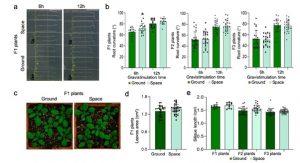 Transgenerational memory can occur through epigenetic regulation of gene expression (for example through DNA methylation) when plants have been exposed to abiotic stresses. Transferring a specific biochemical adaption to the next generation of plants can help the plant counter stress. Here Xu et al. profiled DNA methylation pattern in Arabidopsis seedlings following spaceflight to determine possible transgenerational memory in the progeny. They found that phenotypic effects of stress of spaceflight was seen in the F1 generation, and the heritability declined as the generations progressed. Root length, flowering time and silique length was increased in the F1 generation of spaceflight treated plants as compared to the ground control F1. The distribution of methylation in the DNA changed due to spaceflight although there were no large-scale changes in the genomic DNA methylation pattern. The protein coding genes of the F1 generation were associated with the methylation pattern. There was evidence of modifications due to space flight in the methylation levels of transposable elements in the F1 generation. The authors found that hypomethylation of nitrate signaling genes TGA1 and TGA4 may contribute to increased efficiency of N absorption in the F1 generation after spaceflight. (Summary by Arun K. Shanker @arunshanker) Commun. Biol. 10.1038/s42003-021-02342-4
Transgenerational memory can occur through epigenetic regulation of gene expression (for example through DNA methylation) when plants have been exposed to abiotic stresses. Transferring a specific biochemical adaption to the next generation of plants can help the plant counter stress. Here Xu et al. profiled DNA methylation pattern in Arabidopsis seedlings following spaceflight to determine possible transgenerational memory in the progeny. They found that phenotypic effects of stress of spaceflight was seen in the F1 generation, and the heritability declined as the generations progressed. Root length, flowering time and silique length was increased in the F1 generation of spaceflight treated plants as compared to the ground control F1. The distribution of methylation in the DNA changed due to spaceflight although there were no large-scale changes in the genomic DNA methylation pattern. The protein coding genes of the F1 generation were associated with the methylation pattern. There was evidence of modifications due to space flight in the methylation levels of transposable elements in the F1 generation. The authors found that hypomethylation of nitrate signaling genes TGA1 and TGA4 may contribute to increased efficiency of N absorption in the F1 generation after spaceflight. (Summary by Arun K. Shanker @arunshanker) Commun. Biol. 10.1038/s42003-021-02342-4
SHOOT: Phylogenetic gene search and ortholog inference
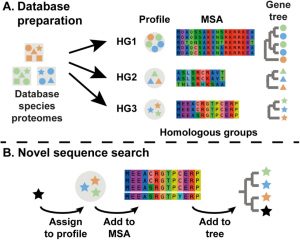 BLAST (basic local alignment search tool) is more than 30 years old, and most readers have probably had the opportunity to BLAST a sequence. BLAST takes an input sequence and searches databases for closely related sequences. However, this tool uses only sequence information to find close matches. Hypothetically, two sequences that have very different origins but have converged on the same sequence would show up as a match – useful, but perhaps implying a close evolutionary relationship that they don’t share. Here, Emms and Kelly present SHOOT, where you can “sprout a branch on the tree of life“. SHOOT queries pre-constructed phylogenetic datsbases (you can search all life, or select just plants) so it’s fast and provides you with a “phylogenetic tree with your query sequence grafted into it“. SHOOT is provided for use at www.shoot.bio. Grab your favorite amino acid sequence and try it! (Note that when I used this I had to edit out all spaces from my amino acid sequence manually.) This will be an excellent tool for teaching, too! (Summary by Mary Williams @PlantTeaching) bioRxiv
BLAST (basic local alignment search tool) is more than 30 years old, and most readers have probably had the opportunity to BLAST a sequence. BLAST takes an input sequence and searches databases for closely related sequences. However, this tool uses only sequence information to find close matches. Hypothetically, two sequences that have very different origins but have converged on the same sequence would show up as a match – useful, but perhaps implying a close evolutionary relationship that they don’t share. Here, Emms and Kelly present SHOOT, where you can “sprout a branch on the tree of life“. SHOOT queries pre-constructed phylogenetic datsbases (you can search all life, or select just plants) so it’s fast and provides you with a “phylogenetic tree with your query sequence grafted into it“. SHOOT is provided for use at www.shoot.bio. Grab your favorite amino acid sequence and try it! (Note that when I used this I had to edit out all spaces from my amino acid sequence manually.) This will be an excellent tool for teaching, too! (Summary by Mary Williams @PlantTeaching) bioRxiv



